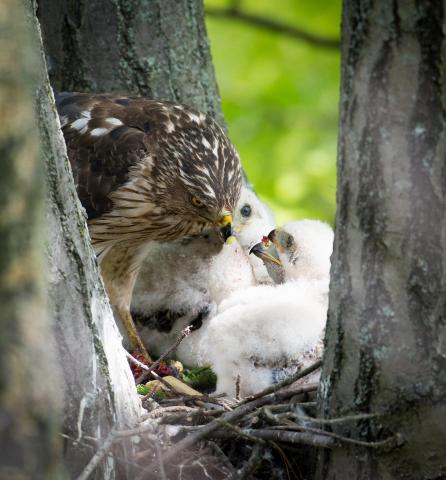
A pair of Cooper's Hawks have nested outside Indiana State University's Stalker Hall and have hatched four or five chicks this spring. The presence of the birds of prey indicate the campus has a strong eco-system, a biologist says.

A pair of Cooper's Hawks have nested outside Indiana State University's Stalker Hall and have hatched four or five chicks this spring. The presence of the birds of prey indicate the campus has a strong eco-system, a biologist says.
While the once endangered peregrine falcon and the plentiful American crow may have made the most news in recent years at Indiana State University, they are just two of an estimated 110 to 120 species of birds that call the tree-filled campus home, or are frequent visitors.
The Cooper\'s hawk is the latest bird to create a buzz on campus. Adam Betuel, a doctoral student in biology, first heard the hawk\'s monkey-like call outside the Science Building in March. With binoculars in hand, he stepped outside to investigate and found a pair of hawks perched in a nearby tree. The next day he discovered the birds building a nest in a tree outside Stalker Hall. In May, they hatched \"definitely four nestlings, potentially five,\" he said.
While Cooper\'s hawks don\'t have as dramatic a presence as falcons, or as annoying as crows, \"they are probably more common than we notice - even for someone like me who is out birding all the time,\" Betuel said. \"They are around, but they are harder to detect. Maybe because they prefer wooded areas, they stay hidden. They don\'t soar and attack but they are beautiful and they are pretty adept at navigating dense wooded areas that a lot of birds of prey can\'t.\"
The Cooper\'s hawk is about the size of the crow and females are larger than the males, he said. The species is prevalent throughout the United States and southern Canada.
Because the Cooper \'s hawk feeds on other birds and small mammals, its presence is an indication that the Indiana State campus has a healthy wildlife population, Betuel said.
\"Just the two adults alone, not to mention their four or five offspring, have to catch a lot of birds to get those chicks out of the nest and healthy,\" he said. \"It\'s a good indicator that it\'s a thriving place for wildlife; there are good trees for the small birds to nest, which unfortunately have to sometimes produce the prey for the bigger things. It\'s a complete eco-system. If it wasn\'t quite so well-rounded you might not have these predators around.\"
Photo: http://isuphoto.smugmug.com/Other/Media-Services/Media-Sciences/Coopers-Hawk/i-tNqxTs2/0/X3/06_04_15_coopers_Hawk-1035-X3.jpg - A female Cooper\'s hawk tends to her chicks on the Indiana State University campus June 4, 2014. (ISU/Tony Campbell)
Contact: Adam Betuel, doctoral student, biology, Indiana State University, abetuel@sycamores.indstate.edu
Writer: Dave Taylor, media relations director, Office of Communications and Marketing, Indiana State University, 812-237-3743 or dave.taylor@indstate.edu
Â